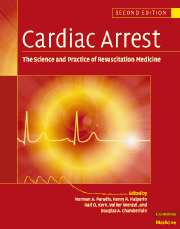Book contents
- Frontmatter
- Contents
- List of contributors
- Foreword
- Preface
- Part I Introduction
- Part II Basic science
- Part III The pathophysiology of global ischemia and reperfusion
- Part IV Therapy of sudden death
- Part V Postresuscitation disease and its care
- Part VI Special resuscitation circumstances
- Part VII Special issues in resuscitation
- 66 The ethics of resuscitation and end of life decisions
- 67 The economics of treating sudden cardiac arrest
- 68 Medicolegal aspects
- 69 The near-death experience, long-term psychological outcomes and support of survivors
- 70 CPR training
- 71 Consensus development in resuscitation: the growing movement towards international emergency cardiovascular care guidelines
- Index
70 - CPR training
from Part VII - Special issues in resuscitation
Published online by Cambridge University Press: 06 January 2010
- Frontmatter
- Contents
- List of contributors
- Foreword
- Preface
- Part I Introduction
- Part II Basic science
- Part III The pathophysiology of global ischemia and reperfusion
- Part IV Therapy of sudden death
- Part V Postresuscitation disease and its care
- Part VI Special resuscitation circumstances
- Part VII Special issues in resuscitation
- 66 The ethics of resuscitation and end of life decisions
- 67 The economics of treating sudden cardiac arrest
- 68 Medicolegal aspects
- 69 The near-death experience, long-term psychological outcomes and support of survivors
- 70 CPR training
- 71 Consensus development in resuscitation: the growing movement towards international emergency cardiovascular care guidelines
- Index
Summary
The most important factor in survival from sudden cardiac arrest is the presence of a trained rescuer who is equipped to intervene. The most effective tools of the trained rescuer are CPR and defibrillation. CPR has been taught as a formal program to professionals since the late 1960s and to the lay public since the early 1970s. The program has changed markedly in scope and complexity as well as educational format and philosophy since its inception. Resuscitation councils that promote and teach CPR have sprung up around the world. Yet, despite this long history of the availability of CPR programs and their promotion, most victims of cardiac arrest do not receive bystander CPR. Moreover, when CPR is performed, the quality of the CPR is often not ideal. Although the development of the automated external defibrillator (AED), its increasing affordability, widespreadpromotionandavailability tonon-professionalshave all contributed to earlierdefibrillation, thenumberof people who are resuscitated is still limited by the low numbers of people who receive bystander CPR before defibrillation and the often poor quality of CPR when it is provided.
This chapter will address the challenge of teaching CPR effectively in various contexts: to the lay public, to laypersons with a duty to respond (such as police, fire, lifeguards, and airline employees), and to healthcare professionals. It will also discuss advanced educational technologies and present a model for new course development.
Teaching CPR
The lay public
Bystander CPR has consistently been shown to more than double the odds of survival from sudden cardiac arrest (SCA).
- Type
- Chapter
- Information
- Cardiac ArrestThe Science and Practice of Resuscitation Medicine, pp. 1258 - 1277Publisher: Cambridge University PressPrint publication year: 2007



